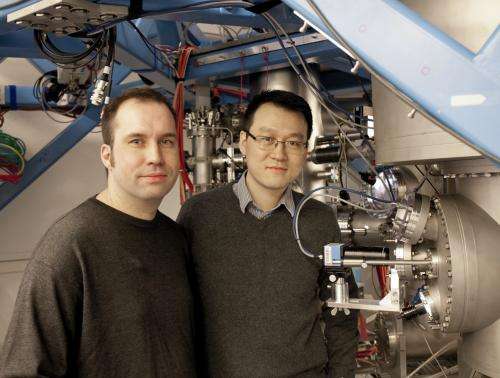Researchers move an atom inside a crystal and investigate its function

Nanotechnology is a thriving science. Parts for computers for example are becoming smaller and more precise by the minute. One of the most efficient computers would be the so-called quantum computer. Up to now, its existence has been merely a concept that is based on the laws of quantum mechanics. Here, the ability to control the state of single atoms is decisive. For the first time ever, scientists of Kiel University have managed to move single atoms vertically inside a crystal. This is important for the further development of nano structures. Simultaneously, the physicists found a method for measuring a transistor-like behaviour of single atoms. These findings have recently been published in the scientific magazine Nature Communications (January, 3rd, 2014) as well as in the renowned Physical Review Letters.
When manufacturing nano structures, the understanding, analysing and handling of materials present major challenges. A widely used and investigated material for piezo-, micro-, and optoelectronic devices is zinc oxide (ZnO). As a semiconductor it is built into light-emitting diodes (LED) and LCD-displays. Also, it is used as nanowires in electrical measurement technology. Some of its properties – such as the conductivity of the pure material – have to date not been understood. A major step towards solving this mystery was recently made by Dr. Hao Zheng, Dr. Alexander Weismann and Professor Richard Berndt of the Institute of Experimental and Applied Physics at Kiel University. While experimenting at the Collaborative Research Center "Magnetoelectric Composites – Future Biomagnetic Interfaces," Zheng was analysing zinc oxide with the scanning tunnelling microscope (STM). This device is able to image crystals on an atomic scale. He discovered circular structures in the otherwise irregular surface. "We found that they are a result of zinc atoms that were incorrectly positioned in the crystal lattice", says Zheng.
Each of the discovered atoms featured two rings – a clear proof that it can donate two electrons. "We studied all scientific literature to find out that no-one had so far proven why zinc oxide is conductive. The logical conclusion was that the reason must lie within the newly found zinc atoms, which are naturally occurring in this material."
Further research led Dr. Zheng to discover that the ring's size could be varied while being exposed to experiments in the scanning tunnelling microscope. He asked for the help of his colleague Weismann, who is an expert for model calculation. "The calculation hinted that the diameter of the ring revealed something about the depth of the atoms below the surface", says Weismann. With this it was clear that Zheng had discovered a way to change the position of an atom by a single atom's width. "This is the first time a single atom is controllably moved within a crystal with atomic precision", Weismann stresses. "This ability will be helpful when designing nano structures in laboratories."
Along with their other findings, the scientists of Kiel University noted a behaviour that was similar to that of transistors. This component, which is used in computers by the million, usually requires three contact electrodes. When working with nano structures such as atoms, which measure only 0.3 nanometers, three electrodes would inevitably cause a short-circuit. "With the help of the STM we have discovered a method that only needs two electrodes, one of which is movable." This also is a major step for the handling of nano structures.
More information: Zheng, H. et al. Tuning the electron transport at single donors in zinc oxide with a scanning tunnelling microscope. Nat. Commun. 4:2992 DOI: 10.1038/ncomms3992 (2014). www.nature.com/ncomms/2014/140 … full/ncomms3992.html
Journal information: Nature Communications , Physical Review Letters
Provided by Kiel University




















